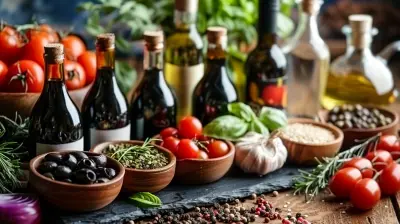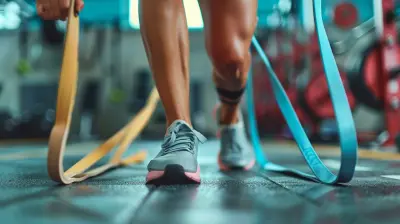Enhancing Athletic Performance Through Stretching
10 July 2025
If you're an athlete or just someone who loves pushing their body to the limit, you’ve probably heard about the importance of stretching. But do you really know how much of an impact it can have on your performance? Spoiler alert: It’s a game-changer! Stretching isn’t just some warm-up ritual—it plays a crucial role in improving flexibility, preventing injuries, and even boosting overall performance.
Let’s dive deep into how you can enhance your athletic performance through stretching, the different types of stretches, when to do them, and some pro tips to maximize your results. 
Why Stretching Matters for Athletes
Ever tried running on stiff legs or lifting weights with tight muscles? Yeah, not fun. Stretching keeps your muscles flexible, strong, and ready to handle the stress of physical activity. Without it, your muscles become short and tight, increasing the risk of strains, sprains, and injuries.Here’s why stretching should be a non-negotiable part of your routine:
- Improves Flexibility – Better flexibility means greater range of motion, leading to smoother, more powerful movements.
- Enhances Recovery – Stretching helps increase blood flow to your muscles, speeding up recovery and reducing soreness.
- Prevents Injuries – Loose, flexible muscles are less prone to tears and strains.
- Boosts Performance – Proper stretching can improve posture, coordination, and even power output. 
Types of Stretching and When to Use Them
Not all stretches are created equal. The key is knowing which type to use and when.1. Dynamic Stretching (Before a Workout)
Dynamic stretching involves moving your muscles and joints through their full range of motion. Think of it as giving your body a wake-up call before a workout. These stretches warm up your muscles, improve circulation, and enhance mobility.Examples of dynamic stretches:
- Leg swings
- Arm circles
- Walking lunges
- High knees
- Butt kicks
Best time to do them: Before a workout or sports activity.
2. Static Stretching (After a Workout)
Static stretching involves holding a stretch for a prolonged period (usually 15-30 seconds). This helps lengthen muscles, reduce stiffness, and promote relaxation.Examples of static stretches:
- Hamstring stretch
- Quadriceps stretch
- Shoulder stretch
- Butterfly stretch
- Triceps stretch
Best time to do them: After a workout or during cooldown sessions.
3. Proprioceptive Neuromuscular Facilitation (PNF) Stretching
PNF stretching is a more advanced technique that involves stretching a muscle, contracting it, and then stretching it further. It’s highly effective for improving flexibility and muscle performance.Example of PNF stretching:
- Partnered hamstring stretch (where a partner helps push the stretch further)
Best time to do them: After workouts or as part of a flexibility-focused session.
4. Ballistic Stretching (Use With Caution!)
Ballistic stretching involves using momentum to push your body beyond its normal range. Think of bouncing into stretches. While athletes in high-speed sports may use it, there’s a higher risk of injury if done incorrectly.Examples of ballistic stretching:
- Bouncing toe touches
- Rapid leg swings
Best time to do them: Advanced athletes may incorporate them before explosive activities like sprinting or jumping. 
How Stretching Improves Athletic Performance
Now that you know the different types of stretching, let’s talk about how they actually boost performance.1. Increases Mobility & Range of Motion
A greater range of motion allows your joints and muscles to move freely, making movements like sprinting, jumping, and lifting feel effortless. If you want to maximize your performance, increased mobility is non-negotiable.2. Boosts Muscle Efficiency
Tight muscles require more energy to perform the same movements. Stretching allows your muscles to work more efficiently, reducing energy waste and improving endurance.3. Enhances Speed and Power
Athletes in sports like basketball, soccer, and sprinting rely on bursts of speed and explosive movements. A flexible body allows for greater stride length, better agility, and quicker reaction times.4. Reduces Muscle Stiffness and Fatigue
Ever felt like you were dragging dead weight after a tough game or workout? Stretching increases blood circulation, ensuring your muscles get enough oxygen and nutrients to recover faster.5. Improves Posture and Balance
Good posture isn’t just about looking confident. Proper alignment can prevent injuries and improve movement efficiency, especially in sports that require precision like gymnastics, weightlifting, and even golf.
Common Stretching Mistakes to Avoid
Even though stretching is great for performance, doing it wrong can be counterproductive. Here are some common mistakes to watch out for:1. Skipping the Warm-up
Never stretch cold muscles! Always do a light warm-up (jogging, jumping jacks, or dynamic stretches) to get your blood flowing before diving into deeper stretches.2. Holding Your Breath
Breathing helps muscles relax and improves oxygen flow. Always breathe deeply while stretching.3. Overstretching or Bouncing
Going too deep into a stretch or bouncing can cause injuries. Stretch to the point of slight discomfort, never pain.4. Ignoring Muscle Imbalances
If one side of your body feels tighter than the other, focus on evening things out to avoid muscle imbalances that can lead to poor form and injuries.5. Not Stretching Regularly
One stretching session won’t work miracles. Consistency is key. Stretch daily, especially if you’re training hard.Pro Tips to Maximize Stretching Benefits
- Incorporate Yoga – Yoga is fantastic for improving flexibility, balance, and overall body awareness.- Use Resistance Bands – These help deepen stretches and improve flexibility.
- Hydrate Well – Muscles stretch better when they’re hydrated. Keep that water bottle handy!
- Listen to Your Body – Pushing too hard can do more harm than good. Stretch to comfort, not pain.
Final Thoughts
Stretching is one of those "small things" that can have a massive impact on your athletic performance. Whether you're a sprinter, weightlifter, or weekend warrior, incorporating the right stretches at the right time can make you stronger, faster, and more efficient. Plus, it helps keep those annoying injuries at bay!So, the next time you think about skipping that post-workout stretch, remember—your muscles will thank you later. Stay flexible, stay strong, and keep pushing your limits!
all images in this post were generated using AI tools
Category:
FitnessAuthor:

Jackson Mahoney
Discussion
rate this article
1 comments
Derek Ortiz
Stretching is like a warm-up hug for your muscles—vital for better performance and injury prevention!
July 25, 2025 at 2:27 AM

Jackson Mahoney
Thank you! That's a wonderful way to describe stretching—it's essential for preparing our bodies for optimal performance and keeping injuries at bay.


